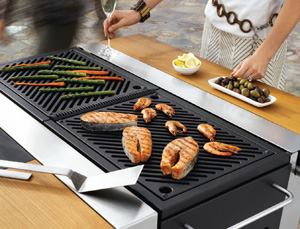Designer Looks. Think all outdoor appliances look the same? Think again. That stainless steel frame is getting a facelift from Fuego North America, which tapped industrial designer Robert Brunner to fashion a distinctive design for its Fuego grill. Brunner, whose works are included in the Museum of Modern Art collections in New York and San Francisco, used farmed teak shelves, slate, and cast iron to develop a look that’s both aesthetically appealing and functional.
Fuego’s grills are part furniture, part cooktop, with the added dimension of a hibachi-style cooking space designed to encourage social interaction. There’s no overbearing hood to contend with, allowing the chef to interact with guests on either side of the grill. Wood and slate slats can be used as prep surfaces or coasters. A quick-change drawer system allows switching from gas to charcoal cooking on the fly, and the gas section offers infrared burner technology for high-heat searing. Fuego’s modular line also includes a shade unit to block out the sun, a wash and cool unit, and storage.
The hibachi concept morphs into Korean barbecue with the Wellbas Premier line of water-cooled grills. Water circulates inside a hollow stainless steel grate, which helps regulate the temperature of the grill surface, according to Keunjin Lee, CEO of Wellbas Ltd. As a result, he says, a chef can use direct cooking from the flame underneath the grate, without charring meat on the grill. Core components of the Wellbas Barbecue System include an electric cooking kit, water tube grid, and heat exchanger, so adequate electrical power should be considered in the planning process.
When you’re developing plans for a new home, remember the outdoor living spaces. Running gas and water lines along with electrical wires can be the difference between having an outdoor grill and a full-blown outdoor kitchen.



